How to create a Little Red Book brand account and store
In recent years, Little Red Book (in Chinese: 小红书 Xiaohongshu, in short RED) has become one of the most popular apps in China, especially among young people. Adopting the unique social e-commerce model, Little Red Book now plays an essential role in boosting new consumption and empowering new brands. Content Seeding on Little Red Book is one of the must-haves of Brands´ China marketing measures. Increasingly more brands have opened their brand accounts and online stores on the Little Red Book.
In this article, you will learn:
- What is Little Red Book and its operation model?
- The benefits of brand account and store on Little Red Book
- How to open a store on Little Red Book to sell products?
1. Little Red Book and its operation model
Established in 2013, Little Red Book was originally designed for consumers to share their experiences of overseas purchases. The later initiation of Little Red Book’s online shopping platform marked the completion of its business loop and extended to a social community integrated with e-commerce functions. Little Red Book adopts a unique operating pattern that most consumption is driven by User Generated Content (UGC). In Little Red Book, users share and discuss their real shopping experiences, while the app analyzes the global purchasing trends and recommends popular commodities to consumers accordingly.
According to QuestMobile, as of October 2019, the number of Little Red Book’s Monthly Active Users (MAU) has exceeded 100 million, marking its position as an important platform for Chinese people’s lifestyles and consumption references. The platform is now an inseparable part of cross-border e-commerce.
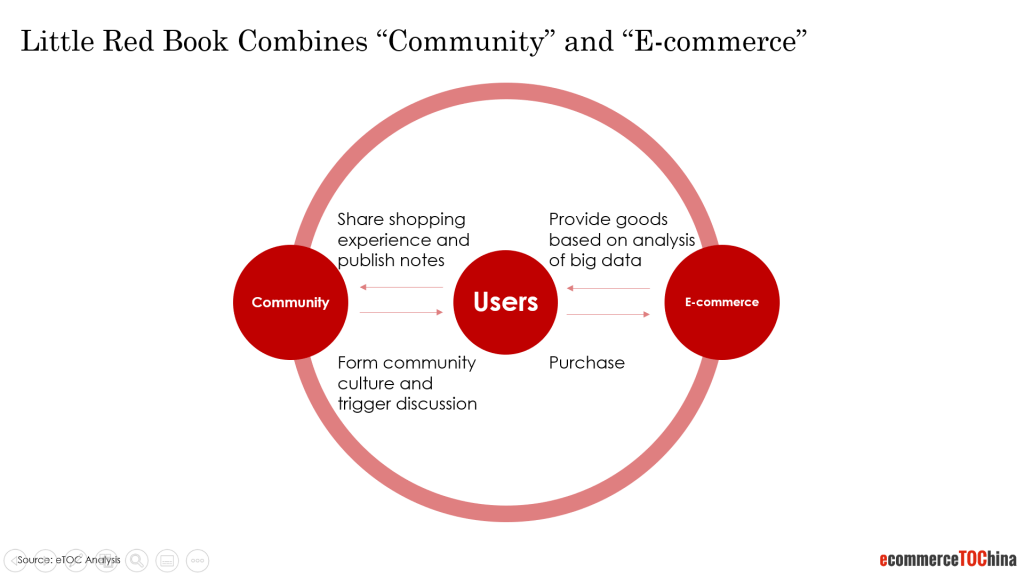
Such combination of “community” and “e-commerce” benefits Little Red Book´s competitiveness. The application of UGC allows the app to gain insights into the market through massive information and data. By analyzing users’ discussion on the platform, Little Red Book is thus able to keep up with current trends and provide users with right content.
The concept of “discovery shopping” resonates very well with Little Red Book potential consumers and results in efficient sales.
According to Guotaijunan, social e-commerce shortens the realization process of commercial activities and achieves a sales conversion rate of 6-10%. Meanwhile traditional e-commerce platforms could only achieve 0.37% on average. Another benefit of social e-commerce is the enrichment of the app with consumer data. After a satisfying purchase, users can share their experience on Little Red Book, which further completes the business loop.
2. Key facts about RED brand account and brand store
In recent years, Little Red Book has reached strategic cooperation with many overseas brands, such as Blackmores, Swisse and La Roche-Posay. To facilitate their entrance into China, Little Red Book also improved the infrastructure. For example, it has set up professional overseas warehouses in over twenty countries, as well as product testing laboratories in case of quality issues of imported products. Moreover, in 2017, Little Red Book established its own international logistic system that enables users to track their packages.
Overseas brands can now set up their own brand accounts on the platform and publish posts. A brand account offers multiple functions.
For now, let’s take the Perfect Diary brand account as an example: On the front page, first, there are the Logo, ID and a brief introduction of the brand, as well as the number of followers and likes, etc. Below “Posts” are previous notes published by the brand account. These Professional Generated Content (PGC) are quite similar to UGC, written in approachable tone and interactive ways. This is one of the most important promotion methods. The brand can also upload short videos and conduct live streaming with this account. The next function is “Engage”, which includes posts by other users with the brand tag. Content posted through collaborations with Key Opinion Leaders (KOLs) or celebrities also appear in this section.
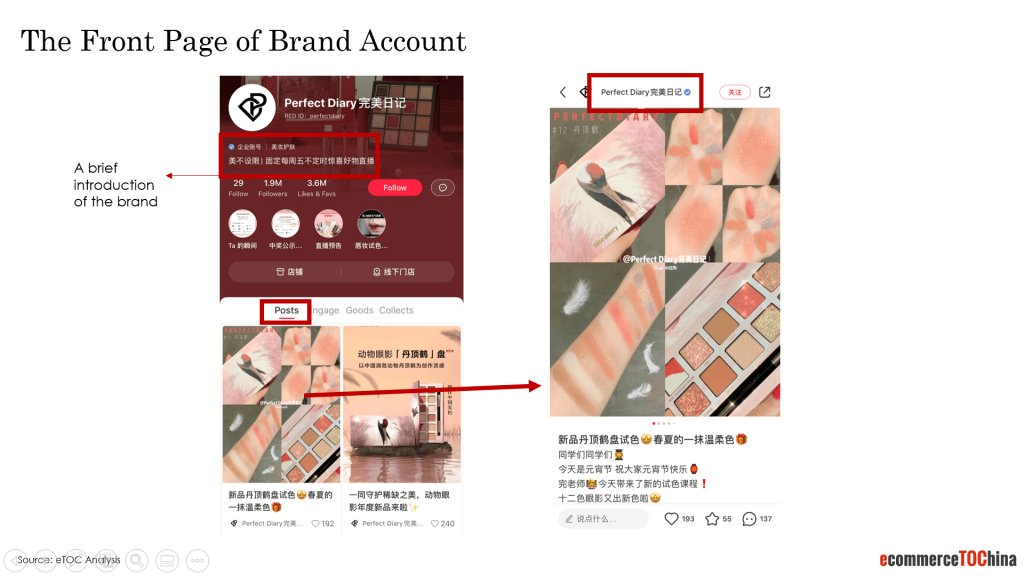
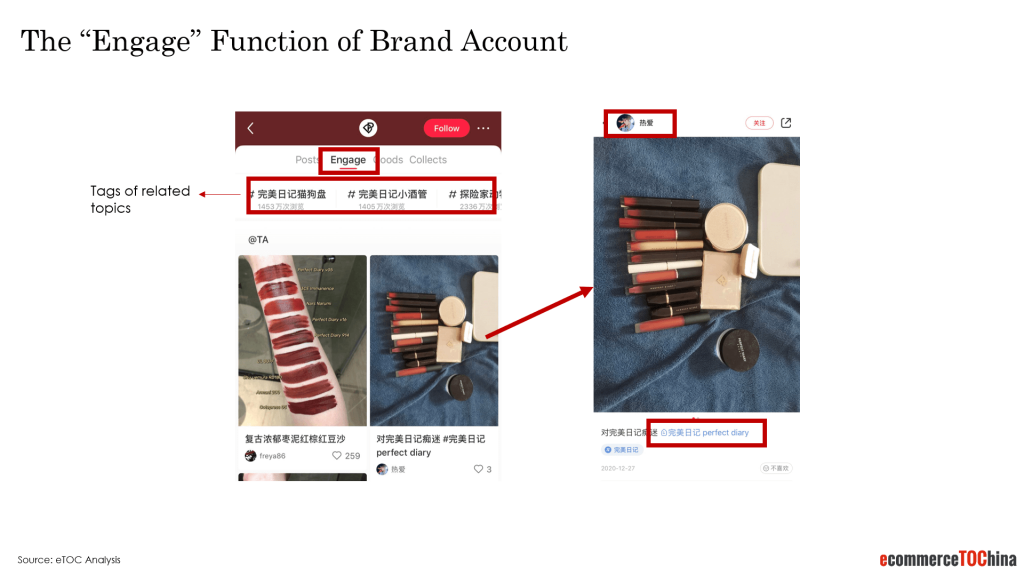
Let’s move on to another feature that a brand account offers:
Foreign brands are allowed to sell directly on Little Red Book. There are two major ways: a brand authorized store and a brand store. Brand authorized stores are run by a 3rd party with the brand letter of authorization, while a brand store is directly managed by the brand. Through the official profile page of a brand account, consumers can directly access their brand store by clicking the “”店铺 Store”” button. In this way, consumers can make purchases within the app. So, they don’t need to open another shopping app separately.

2.1 Advantages of starting a brand account and store
a. Brand account is an essential publicity front of the brand.
The brand account allows companies to customize the account page to convey its own content and style. Through content operation, the brand could better connect and engage with consumers. The content released by the official account is authorized and professional. It can nurture high brand loyalty. It is reported that nearly half of users are encouraged to make subsequent purchases by these posts. Moreover, the brand could also initiate a topic under the brand tag and form the aggregation effect among users. In addition, as mentioned earlier, the account page provides easier access to the brand store. Product links could also be included in these notes. The brand store itself also saves consumers from having to switch to another shopping app. Thus, transactions are completed faster in this way.
b. An official account enables the brand to publish commercial notes.
Only after authentication, the brand is allowed to invite users to publish commercial promotional posts in collaboration. Advertising content can only be posted by brand accounts and certified brand partners. Without an official account, brands could hardly conduct commercial campaigns.
c. Little Red Book equips brand accounts with multiple data support.
After setting up an official account, a brand now has multi-dimensional data support. At the backstage of the brand account, the brand could view various types of data. Little Red Book analyzes the portrait and variation of the current followers. It also evaluates performance, such as click-through rate and page views. In this way, brands could better understand present performance and analytics and thus attain healthy growth on the platform.
2.2 How to create brand account and store on Little Red Book
To create a brand account on Little Red Book, the brand first needs to register a regular account and link it to a telephone number. It then needs to go to the Enterprise Platform (https://business.xiaohongshu.com/ares/login), log in, and complete the account authentication. The following information is necessary:
- Information of the account and the enterprise
- Business license with official seal or signature
- Certification letter
- Other supplementary documents
After submitting the application and paying the certification fee (RMB600), Little Red Book will start the review and inform the company in a week. If its qualification meets the standards, the company will be able to start the brand account soon.

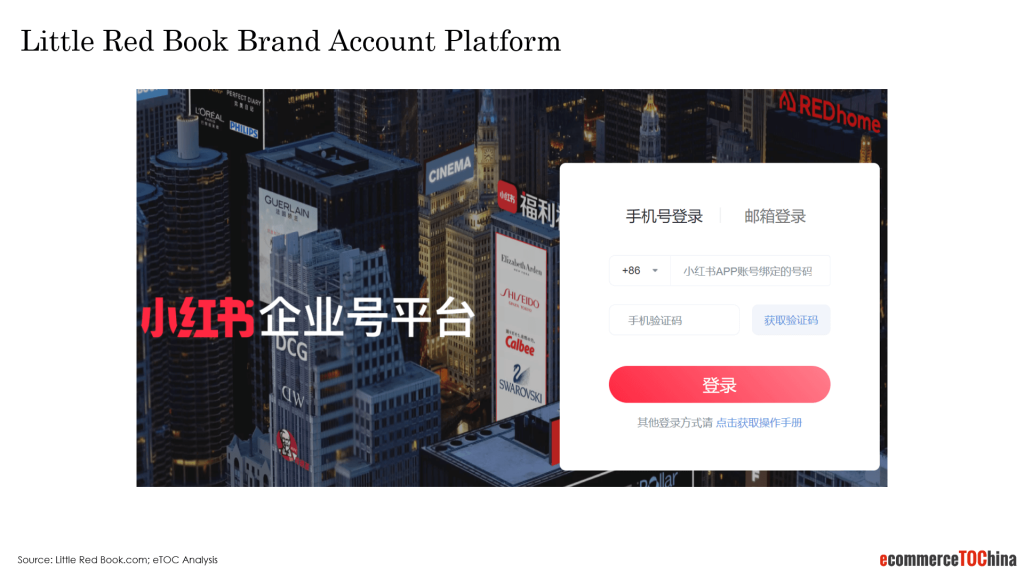
The registration of brand store is conducted separately from that of the brand account. As mentioned above, a brand store differs from an authorized store in that it is directly managed by the brand. Therefore, we recommend the Brand Store because it is simpler and more efficient. To set up a brand store, the company needs to first register on the merchant settlement system and complete the application. The company then needs to provide information of itself and the store. Documents required depends on the type of the store, basically including:
- Business registration
- Certificate of incorporation
- Other company registration file
- Business license
- Financial information…
Once the platform has approved the application, the company should sign the contract and pay deposits. Little Red Book also requests companies to take relevant courses before the brand could start running the store.

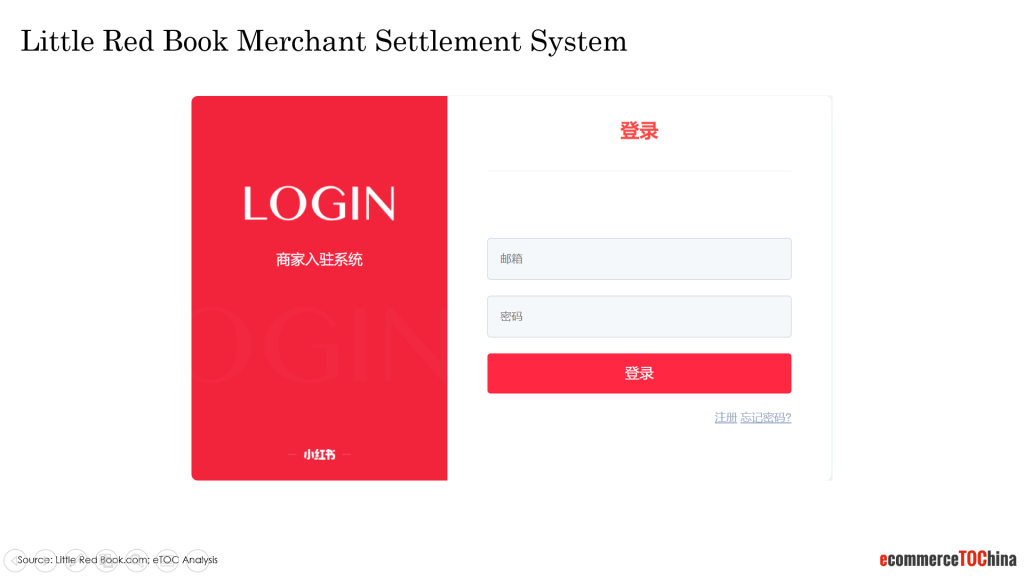
Key takeaways:
To sum up, Little Red Book has become an important platform for overseas brands to start their sales in China. They could establish official brand accounts and brand stores on the app. Little Red Book Brand account and brand store benefit these brands in that they play major roles in brand promotion and sales, and assist in brands’ market analysis with big data support.
The setup of brand account and of brand store are conducted separately, through different systems, but procedures are quite similar.
eTOC provides all-stage assistance in Little Red Book business, including but not limited to: shop and account setup, Little Red Book brand account and store management, KOL cooperation and voice of consumer analysis (see also our article “Social Listening: Voice Of Consumers Analysis”).
If you are interested in more information, please feel free to contact us.
Want to have a first free consultation session about selling and growing in China via e-commerce and digital marketing? Contact us.
